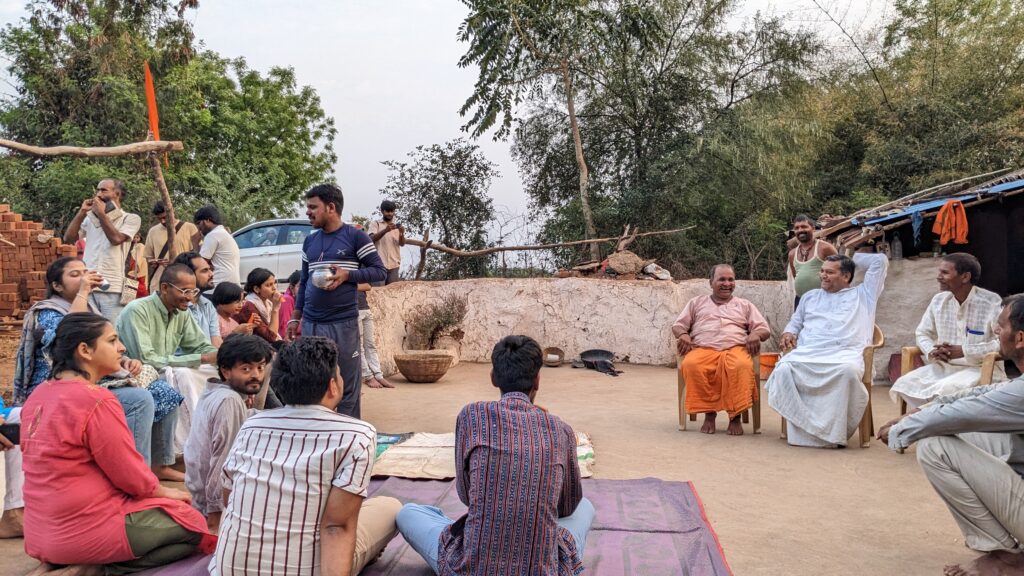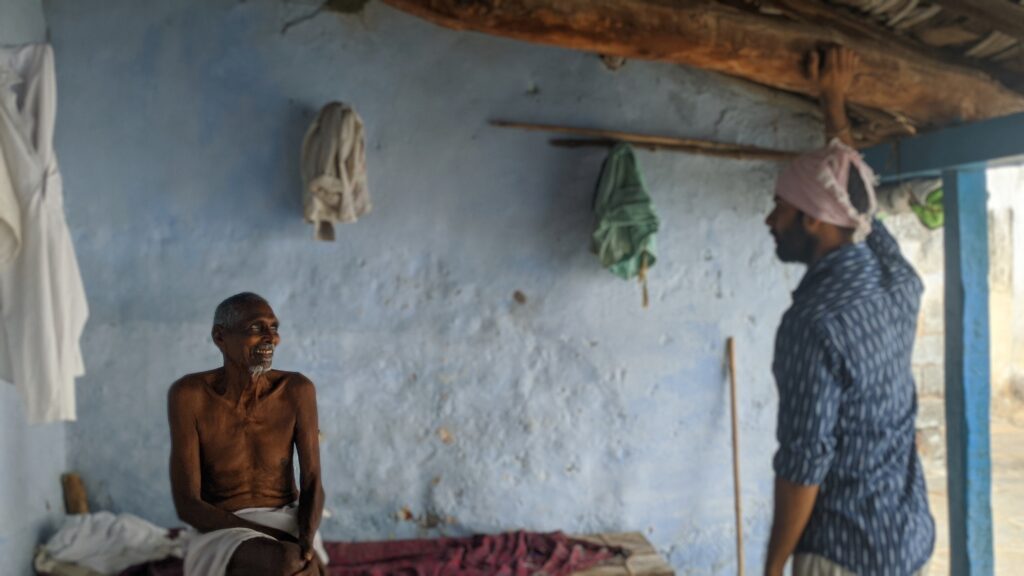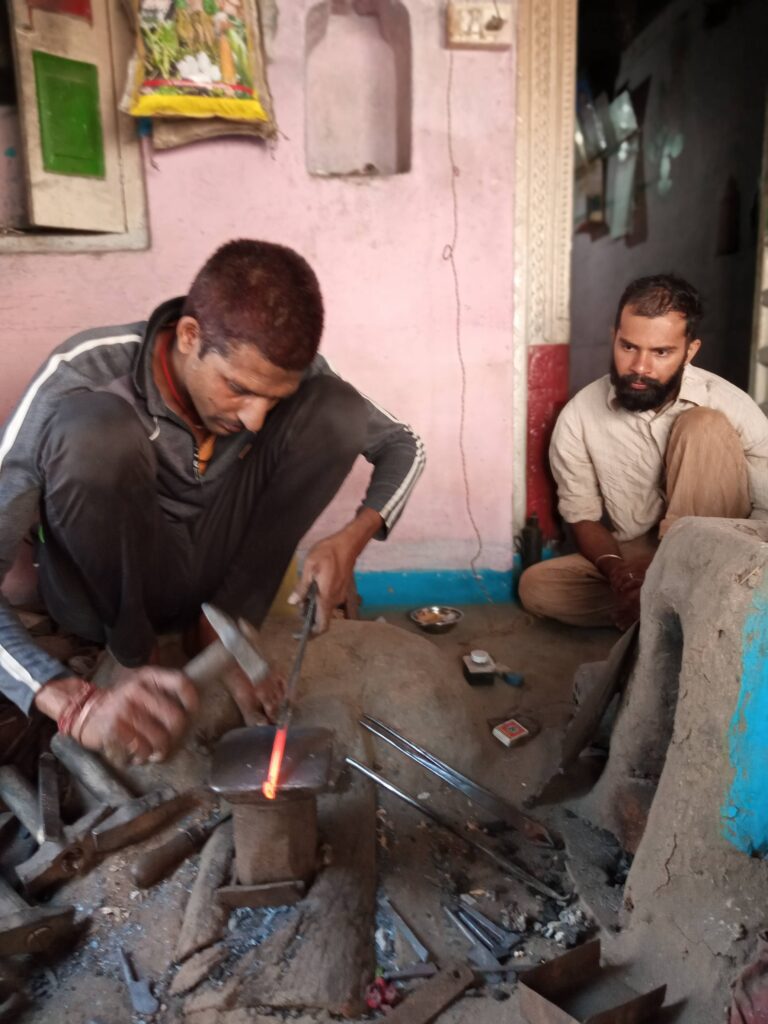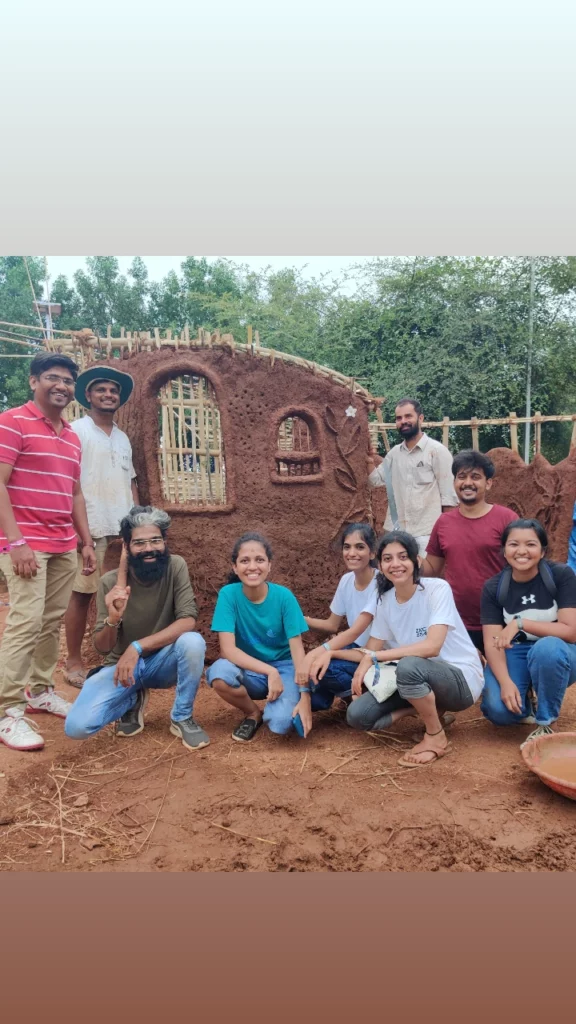A Reverence For The Transparent Sharing Of Grameen Knowledge
Aparna Sridhar | 21 September, 2023
All of us remember the thinnais or aangans of our childhood. A space in time where one could feel the cool breeze in hot summers, and also a place to rest for a weary traveller. Dheeraj Annapureddy is a fellow at the Center for Embodied Knowledge and brings to us the value of these places through his work and thoughts. Let us dive in to hear Dheeraj’s words on grameen architecture
 Front yard Bamboo artisan Halke
Front yard Bamboo artisan Halke
Can you share your personal journey in rooting architecture and the challenges faced by you.
I have grown up in urban spaces always, mostly in the vicinity of many villages, education kept me away from my villages, the language and the culture around.
The little exposure of an Indian village in those days would be the occasional visit to my Mother’s village ‘ ఈదులూరు Eeduluru’, it was like stepping into a completely new world.
‘ పొద్దు పొద్దున్నే ఆవుల బర్రెల మందల హడావుడులు
మగ్గాల సప్పులు, వంటింట్లో అమ్మమ్మ కాస్తున్న కమ్మని పాలు,
గా పెద్ద ఆంగన్ల సాంపి సల్లుతున్న చిత్రమ్మ, ఆపై అమ్మమ్మ ముగ్గులు చేసే కనువిందులు
జనాల సిందర మందర గుంపులు,ఆడ ఈడ ముచ్చట్లు
అడుగు బైట పెడితే ప్రేమ ఆప్యాయతలు పలకరింపులు
బతుకమ్మ ఆడేకి పోయే వూరి గుట్ట,
నిద్ర పోనీయకుండా కూతులు కాస్తున్న పాల పిట్ట ‘
The above is a beautiful Telugu description of an early morning in a village
The morning is the busiest, the many herds of cows and buffaloes that are moving towards the farm fields, the rhythmic sounds of the small-scale power looms, the sounds of birds waking you up, it’s the morning orchestra of a humble village.
 Front yard Meetings and Chai
Front yard Meetings and Chai
The big Aangans – front yards are first cleaned with water and the cow dung that Chitramma collected yesterday is now spread carefully, grandmother would be ready to welcome the visitors with a beautiful ‘Muggu’.
In festivals like ‘Bathukamma’ the whole village goes out in a procession to the sacred hill in the outskirts of the village, a stream of people flowing through with many million seasonal flowers on their heads. The homes in the gulleys from the main spinal road of the village, the people living in them used to fascinate me, you have bullock carts and many cycles coming from them. There was a village doctor’s mansion I had once visited which is so big I could easily get lost, curving roads adorned along by earthen walls were nothing less than the huge curving stone walls of the Jaisalmer fort for the little child I was.
Following this would be again few memories of visiting Ellora caves in Maharashtra. I did pass by many beautiful homes that were mere glimpses and I would regret for not pausing long enough. It’s again during my bachelors in Architecture in Bhopal, I could connect back with nature, it’s the city of lakes and places like Bharat Bhavan left a great impression on me. Spending some time in the older parts of the cities and with the urban “poor” is when I felt like the villagers again are around me, humble and welcoming. I had a feeling that this was my calling, to serve them, to help in designing homes for them.
We had an opportunity to volunteer on behalf of the college’s rotary club, to start tuitions in the evenings, we would be going around in the colonies and calling out for the kids who have registered for the program. I learnt more about a village while being in the city, what I thought would be the issues weren’t actually their only concerns.
 Interactions with the genration who have seen the changes from rural to urban
Interactions with the genration who have seen the changes from rural to urban
The problems that we try to address on hygiene, congested spaces for the people in these spaces from the comfort of our ‘in grid homes and institutions ‘ results in solutions which kill the social fabric and organic structures that have developed over decades. Social Architecture needs to be better understood, this took me to Kiran ji and Sandeep ji at Hunarshala. I had the opportunity to intern at Hunarshala but my college didn’t recognise it to be something valuable, so I could only get a glimpse of their work while volunteering for a few weeks after my official internship program. Social Architecture, Participatory designing, Owner-Builder are few terminologies I came across, the brief experience had been overwhelming and I was not in a mood to slow down, pause and observe but in the hurry of wanting to just know more (learn less). This is something any youngster would go through, thrilled with such happenings and take part in everything at once.
I had this push and pull again in the few initial months while I was with my gurus Biju Bhaskar ji and Sindhu Bhaskar ji at Thannal in Tiruvannamalai. The greatest learnings began here, the artisans are not mere tools for a designer to bring her/his imaginations into reality. Especially here in the realm of ‘Grameen Architecture’, a process in which the design is finetuned and brought into reality by artisans, it is a collaboration, a collective effort that can be only understood by practicing consistently along with them. It is also about what is beyond the materials and technical knowledge they offer, it is a reverence we are ought to show for the transparent sharing of their knowledge and skills that come along from so many generations of artisans.
 Artisans like Anil ji are very valuable and collaborations with them would have a profound effect while blending traditions with natural growth
Artisans like Anil ji are very valuable and collaborations with them would have a profound effect while blending traditions with natural growth
I am blessed to have seen my gurus meditate and bring back these ancient practices, these are then woven into stories that all of us could easily ingest and learn along with the artisans.
Today we are a team of diverse practitioners around ecology and culture, this very strength inspires us to deep dive to understand the ‘Native Buildings’ beyond their physical structure and understand the tangible and intangible narrations.
The idea is to deliver the documented works to the coming generations in a form and medium they would easily relate and understand. I am very appreciative of the fact that organisations like CEK are coming forward to support our endeavours.
 A weaver in his 70s weaving Ilkat saris – has his family across all ages are helping him to get it to thi stage
A weaver in his 70s weaving Ilkat saris – has his family across all ages are helping him to get it to thi stage
How integral is architecture in preserving culture? Do you feel that as native styles of architecture are disappearing, it also erases the roots of native cultures?
Imagine yourself approaching a village, any village in India. You will see Aangans, big front yards sometimes, if not those, at least a small verandah, a shaded space for passersby to sit and chat with the residents. You would actually sometimes even see animals taking shelter under these tiny shaded areas. These typical scenes are a result of conscious design elements which account for and accommodate social interactions and are an essential part of our welcoming village culture.
A big front yard is also an essential space for a potter family to function, they mix the soil there, store the soil under a tree. They put up their kiln in one corner of this front yard. They dry the pots out in the sun in these open spaces. The presence of these spaces is essential to their profession.
In modern architecture, the focus on privacy means less social interactions. We also need more space to spread our furniture, unlike the minimalistic life in villages where the same space serves multiple purposes. Storage spaces are mostly niches within the wall or vertical spaces to hang things. Even the furniture is multi functional, trunks that are used for storage are also used as sitting or sleeping spaces.
A lot of semi open spaces, like the ones in villages, mean a lot of ventilation and a lifestyle that is in tune with the weather and wind flow. An absence of these spaces affect the health slowly.
We still have rituals and other systems to keep the village together, but a change in the design of personal spaces are like a slow poison, leading to a change in lifestyle, causing discomfort and less social interactions. These are slowly disintegrating the social fabric and the culture of the village itself.
 Teaching them young the joy of Hand made
Teaching them young the joy of Hand made
Often during the environmental conversation endeavours organised by urban societies, the locals are excluded from the efforts. This is rooted in the idea that locals do not understand the need for conservation and do not have sustainable practices, while in fact, the opposite is true. How would you recommend that general conservation measures be carried out in harmony with the locals, the way you have done with sustainable architecture?
The common perception is that humans always affect their environment negatively, and conservation efforts are generally about creating boundaries, separating humans from nature.
But we have seen that the recent events of uprooting tribal communities from forests have had adverse effects on the ecology of those places, as the balance that their presence created was disturbed. The tribals are the true ecologists/naturalists who know every inch of the forest like their own body, and its changes through the seasons, through the years. They know how to work within the limits that nature sets for them.
Just like tribals are in tune with and integral to their forests, traditional village systems are also conscious of their limited resources, and have sustained a circular economy within. These systems were the inspiration for the old urban spaces as well, and the locals of these spaces are as well rooted to their surroundings as the tribals are to forests. We need to value the knowledge they have, and include them in any conservation efforts that are planned around them, and only then will these plans be effective and long lasting.
A collaboration between the government, scientists and locals is needed for policies, funds, technical know-how, local knowledge to come together, and the ownership of these efforts should reside in the hands on the locals. Without them, it will be an isolated effort and a lot of external resources, manpower and continued external maintenance will be required unnecessarily.
We still have many such places in India that can be best understood by working with the people who have been there since multiple generations, and probably still have memories of harmonious living.

Workshop on Local Thatches
How do you feel native styles of architecture can be brought to the urban landscape? Do you feel it is a viable shift for big cities to make, not just more rural areas?
Anything built today in the urban landscape is with the materials that have a huge carbon footprint and are often not processed enough to mask their toxicity. The workforce who handle them take the brunt while handling them, the users who later occupy the spaces are also then exposed to the hazardous materials. The spaces are also not anthropometrically designed, they are also designed to discourage socialisation and to put forward a very individual pursuit of economical development.
Native architecture is completely the opposite, it is highly human centric, ecologically conscious, values social spaces at every level (often prioritised are public and semi-public spaces over personal space during the design).
A simple beautiful example that we have encountered here in Indrana (Jabalpur,Madhya Pradesh) – A villager was arguing with the building contractor about why he doesn’t need to have a door facing the road, he tells the contractor that his friends and guests should be hosted in the main ‘Aangan’ and not in any segregated space.
The cities in their pursuit to expand are ruthlessly intruding into villages around them and the rampant urbanisation is affecting the social fabric and customs in a way that is disintegrating the culture into mere rituals. The most viable way to adopt Native Architecture would be to start by conserving the existing while carefully planning the city expansions. This is one way to value the knowledge that the humble artisans have been carrying through generations and to have the possibilities of collaborating with them to innovate solutions for the new Urban India.
In addition to the sustainable nature of the architecture, this work also brings work to traditional workers. Is this a shift that you see happening in fields other than architecture?
Yes this is part of a larger philosophy, which is really coming from our tradition, that everyone should have meaningful work.
The modern way tries to minimise the number of workers as a cost saving measure, but it is wasteful in its use of materials.
This is not just true of Architecture but everywhere from farming to production of clothing, utensils, footwear etc.
For example in Architecture, the simplest way to take ‘Grameen architecture’ forward is to get as many youngsters trained in its various forms, this is to be facilitated after considerable amount of research and development in collaboration with the very artisans who are still holding them in the tip of their fingers.
This effort is to not again to produce firms that only serve the rich for their fancies of sustainability but also for these youngsters to adopt this for themselves and their families and build ‘homes’ their way, the indigenous way.
We are thankful to organisations like ‘Hunarshala’ and ‘Hunar Gurkul’ who are stepping forward to train new generation of Masons, Carpenters and Thatchers. Centres like these are a must in every corner of the country to take forward the fraternity of ‘Grameen Architecture’.
When I look into the other extensions of this holistic lifestyle, for example, as travelling far becomes economical, the many youngsters who have taken interest in traditional art forms are reaching out to the artisans to witness it in first hand, which in turn is slowly inspiring the sons and daughters of the artisans to look at their own art with new found respect and give more time and attention in practicing it.
 There is always new to learn and realise
There is always new to learn and realise
What would you say is the most impactful change made by spreading awareness and skills through your workshops? What are other ways you are looking to reach out to people who might be interested in these efforts but don’t know how to start?
Sharing indigenous knowledge the way the villagers do is not simple, the fact that these are very social communities and knowledge is not necessarily taught, but shared very wisely & easily through stories and idioms from day to day activities is evident.
The introductory workshops we have been organising are majorly designed around giving the participant the experience of being a fellow villager with the artisans, it is to give them a hands-on experience not just at the skills but also through the processes of procuring – processing – moulding the materials in their native spaces.
It is not just to provide the understanding of the ecology but also about the people, the communities that take part in the sacred circular economies of the village.
People return back with a deep respect towards the artisans, now that they get to interact with them in such close quarters, they realise how precious their “common” wisdom is and that their hands and eyes are carrying forward their skills from generations of learnings.
The impact that is visible and spontaneous is when we have kids joining thier parents in these workshops, the way they interact with the elements of nature, with fellow participants, the way they take an active lead in the activities arranged inspires each one of us, we are always learning around them.
It is a surprise for me to see most of the kids tune themselves with the hands-on activities so well that the adults fall behind and it’s the kids who encourage everyone else to get back to churning earth with bare feet, harvesting ‘Besharam branches’ in the local water bodies etc. The elders observe the kids closely and understand that given an opportunity, the next generations to come are willing to engage and learn in arts and crafts that are close to nature.
The intention is not to ask the elders to completely change their lifestyle and settings overnight, but to understand the needs of the child and make subtle changes in their immediate surroundings to enable a holistic learning aligned with the indigenous traditions and giving them opportunities to interact with our artisans. India still holds her Artisan sons and daughters embraced. We are never too far from an artisan or a villager and learning/unlearning can begin at any point.
In the world of digital mediation dominating information sector, where everything from a hair pin to satellite are ‘ googled ‘ every second, these knowledge systems which rely on physical interactions and communications are fading away very easily. Urbanization starts in the television and mobile screens today. Revival and adoption of indigenous systems into our daily lives has to compete with the speed of climate change.
We are still blessed with few young villagers who have a concern for the disappearing cultures in their own villages, they are integral to the communities and it is them we would want to take the help of, and collaborate to document what is left and alive of the native. It would be through their practice we shall be able to communicate and make more youngsters in the villages aware of their rich culture and the opportunities around them to stay afloat in circular economies.
Awareness starts at home.
Video Excerpt of the Interview

